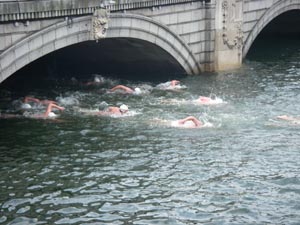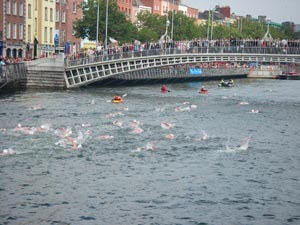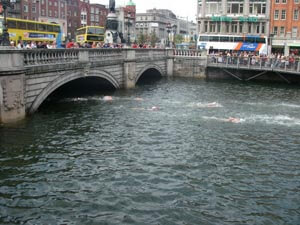Liffey Swim To Take Place in Dublin

By Steve White
DUBLIN, Ireland, March 15. THE Liffey River rises in the Wicklow Mountains south of Dublin. It travels 125 kilometers through to the center of the city and empties into the Irish Sea.
The river is intricately tied to the city's name. When the Vikings arrived in 841, they built a fortified stockade overlooking the Liffey. They called the city Dubh Linn, meaning, ‘the black pool', after the natural blackness of its waters.
The Liffey Swim was born in1920, when a public health worker, Bernard Fagan deemed the water safe enough to swim in. The 2.2km race is swum at high tide when there are fewer pollutants. The first Liffey Swim attracted 27 competitors; and by 2006 it has grown to 330. (There were 230 men and 100 women in the 86th annual race.)
A handicapped event, swimmers range in age from 70's down to teenagers. Last year the race hosted a number of international swimmers and some of Ireland's Olympic hopefuls. Swimmers must qualify for the race by completing five open water swim races. These results are used to calculate the swimmers handicap time. Also, every swimmer must be a member of a club and be able to swim a mile (1.6km).
The race is held on either the last weekend in August, or the first in September. The water is chilly, but in the tradition of open water swimming, wetsuits are banned.
One of the unique features of the race is the numerous bridges that competitors swim under; including some of Dublin's most famous. The Ha'penny Bridge which was built in 1816, so called because it used to cost half a penny to cross it. In the heart of the city is the beloved O'Connell Bridge.
Jackie Kearney, this year's oldest entrant at 75, loves the inclusive nature of the sport and the event. "Old fellas', can compete against kids," he says." He completed his first Liffey swim in 1950 and came second in 1995! This will be the elder statesman's 56th Liffey Swim.
A former Irish swimming champion Rachel Lee said, "…the spookiest part is swimming under O'Connell Bridge. It's 50 meters wide, it's pretty dark and eerie under there. And there are rats."
The water quality on race day is carefully managed. The race is held in the tidal section of the river, so it is flushed twice a day. The race coincides with the Liffey Descent Canoe Race. For this event, the water authority releases 30 million tons of clean water from the Reservoir to raise the river to flood level.
The river is in the process of being cleaned up and it thankfully no longer smells. It is now rich with fish such as Perch, Pike, and Roach. Further upstream, you can find Salmon and Trout.
"That hundreds of swimmers are willing to swim in the Liffey is a sign that we have achieved improved water quality."
The infamous foul-smelling stench of the 'sniffy Liffey' is a thing of the past.
One of the earliest Liffey Swims was immortalized in the Jack B. Yeats 1923 painting entitled The Liffey Swim, which was to win him a silver medal at the 1924 Paris Olympics competition for artistic endeavor. Yeats painted the river as it was in dirtier times – a murky churn of browns, greens and purples. In more modern times, the River Liffey and its surrounds have, and still are undergoing a period of massive redevelopment.
The fire brigade will be on hand with decontamination showers. Other recommendations from participants are; "a can of Coke will kill anything nasty when you've finished, followed by a hot whiskey to warm up."
The Open Sea Committee organizes the race and is part of Swim Ireland www.swimireland.ie





